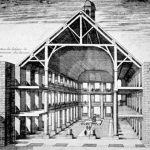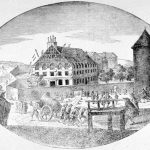A place of worship east of Paris
The Edict of Nantes (1598) forbade the building of temples in Paris, and within five leagues -about ten miles- around the city. So the Reformed met in Charenton, East of Paris.
Jacques II Androët du Cerceau, architect of the Castle of Fontainebleau, had built a first temple in Ablon – in the vicinity of Fontainebleau. As from 1607, Androuët du Cerceau used the Ablon materials once more to build the Charenton temple, a huge edifice that could hold 4.000 worshippers.
In 1621, a fire ruined the first temple in Charenton. In 1623, Salomon de Brosse, Jacques Androuët du Cerceau’s nephew, was in charge of its reconstruction.
The new temple
Following a basilica-type plan, the edifice was 33m long and 19.50m high, with a tiled pavilion roof and a small turret at one end. The light streamed in through 18 windows, 1.3m by 1m, topped with two rows of dormer windows.
Inside, tribunes supported by 20 pillars increased the seating capacity of the edifice. A large staircase in each corner allowed access to the tribunes. The temple in Charenton could seat 4,000 people. The pulpit was one third of the way in the nave. The ceiling featured the Tables of the Law, in gold on a blue background. The doors featured biblical texts.
Destruction of the temple
At the Revocation of the Edict of Nantes in 1685, the Charenton temple was destroyed, dismantled, levelled. Its site became a symbol for the Parisian community which made it famous as the ideal type of Reformed temple.
The wonderful Psalter of the Charenton temple was spared and placed in the Briçonnet diocese library in Meaux (about 100 km East of Paris).
Some Catholic dignitaries were enthralled by the destruction. On the 27th of January 1687 Abbot Talemand declared at the Académie Française : “Blessed ruins, the most beautiful trophy France has ever seen. Arches of triumph and statues honouring the king will not elevate it higher than this heretic temple brought down by his piety”.


















